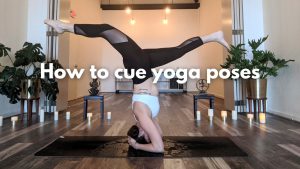What is the Best Way to Cue Yoga Poses?
Best Way to Cue Yoga Poses
Whether you are a seasoned yoga teacher or just getting started, your verbal cues will have a huge impact on the way students feel throughout class. For this reason, it’s important to keep your cues simple and clear. Cues that are too long or complicated can cause students to get confused and may even hurt their feelings.
To avoid overcrowding your students, stick to about three instructions for each pose. This gives you the chance to provide a full range of options for students, so they can choose the one that feels right for them. It also means that students can focus on their breath and build a deeper connection with the poses through their experience of the movements.

Best cues for yoga teachers that involve movement are often easier to teach than static shapes, but it’s still important to think about how the parts of the body are working together in each position. For example, it can be helpful to give alignment cues that will help students stay safe in the pose, such as not pushing their front knee past their ankle in warrior 2 or encouraging them to micro-bend the quadriceps to support the back knee in triangle pose.
What is the Best Way to Cue Yoga Poses?
It is also helpful to remember that most of your students will not have the depth of anatomical knowledge that you might have from teacher training, so it’s important to keep your language simple and direct. Verbal cues like “Step your foot forward,” “Hug your legs close,” and “Lift your back heel” are easy for students to understand and do not require a lot of explanation.
You might also consider adding action cues to your teaching, such as “Slide the hips open,” or “Turn the head to the left.” These are actions that will bring a different feeling to the pose and help students develop more awareness of how their body is moving in the moment.
Once you have the basic alignment and movement cues down, you can begin to refine the pose further. This can include naming the pose (e.g. navasana, boat pose) or focusing on a specific element of the pose, such as the opening of the hips or the energy that is released out through the fingertips.
In addition to these more advanced cues, you might also want to consider adding in a few words of inspiration or encouragement for your students. It can make all the difference for students to feel supported and encouraged, especially when they are struggling with a posture or are experiencing an emotional challenge on their mat. This can really transform the class into a space of compassion, reflection, and self-love. And, of course, it’s an added bonus if students leave class feeling a little more peaceful and joyful!